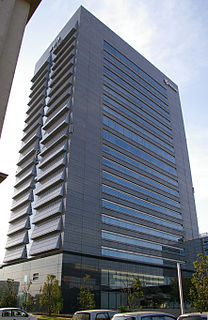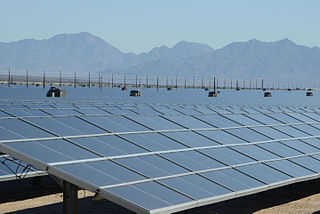
Kyocera Corporation is a Japanese multinational ceramics and electronics manufacturer headquartered in Kyoto, Japan. It was founded as Kyoto Ceramic Company, Limited in 1959 by Kazuo Inamori and renamed in 1982. The company has diversified its founding technology in ceramic materials through internal development as well as strategic mergers and acquisitions. It manufactures industrial ceramics, solar power generating systems, telecommunications equipment, office document imaging equipment, electronic components, semiconductor packages, cutting tools, and components for medical and dental implant systems.

Photovoltaics (PV) is the conversion of light into electricity using semiconducting materials that exhibit the photovoltaic effect, a phenomenon studied in physics, photochemistry, and electrochemistry.

A pyranometer is a type of actinometer used for measuring solar irradiance on a planar surface and it is designed to measure the solar radiation flux density (W/m2) from the hemisphere above within a wavelength range 0.3 μm to 3 μm. The name pyranometer stems from the Greek words πῦρ (pyr), meaning "fire", and ἄνω (ano), meaning "above, sky".

Photovoltaic solar panels absorb sunlight as a source of energy to generate electricity. A photovoltaic (PV) module is a packaged, connected assembly of typically 6x10 photovoltaic solar cells. Photovoltaic modules constitute the photovoltaic array of a photovoltaic system that generates and supplies solar electricity in commercial and residential applications.
Many nations have installed significant solar power capacity into their electrical grids to supplement or provide an alternative to conventional energy sources. Solar power plants use one of two technologies:

Spain is one of the top ten countries by solar photovoltaics installed capacity and the first country for concentrated solar power (CSP) in the world. In 2016, the cumulative total solar power installed was 6,969 MW, of which 4,669 MW were solar PV installations and 2,300 MW were concentrated solar power. In 2016, nearly 8 TWh of electrical power was produced from photovoltaics, and 5 TWh from CSP plants. During 2016 Photovoltaics accounted for 3% of total electricity generation and solar thermal an additional 1.9%.

Solar power is the conversion of energy from sunlight into electricity, either directly using photovoltaics (PV), indirectly using concentrated solar power, or a combination. Concentrated solar power systems use lenses or mirrors and tracking systems to focus a large area of sunlight into a small beam. Photovoltaic cells convert light into an electric current using the photovoltaic effect.
The Moura Photovoltaic Power Station is a large photovoltaic power station in Amareleja, in the municipality of Moura, Portugal. It is one of the largest power stations of its kind, and is built in one of the sunniest regions in Europe. Its construction involved two stages: stage 1 was completed in 2008 after 13 months, and stage 2 was completed in 2010. The entire project topped a total cost of €250 million.
Beneixama photovoltaic power plant is a 20 MW photovoltaic power plant located in Beneixama, Spain. The plant consists of approximately 100,000 solar panels, encompassing an area of approximately 500,000 m2. The panels are City Solar PQ 200 modules made of polycrystalline silicon solar cells. In addition, 200 units of Siemens photovoltaic inverters "Sinvert Solar 100 Master" were installed.
Planta Solar de Salamanca is a 13.8 peak MW photovoltaic power plant located in Salamanca, Spain. The plant consists of approximately 70,000 Kyocera solar panels, occupying approximately 36-hectare (89-acre) site.
Darro Solar Park, also referred to as Solarpark Darro, is a 5.8 MWp photovoltaic power plant located in Darro, Spain. There are a total of 29,964 solar panels on 710 dual-axis trackers, which follows the sun throughout the day. The solar panels, or modules, are Conergy C180M and SunPower STM210, and the trackers are SolarOptimus by Conergy.

A photovoltaic system, also PV system or solar power system, is a power system designed to supply usable solar power by means of photovoltaics. It consists of an arrangement of several components, including solar panels to absorb and convert sunlight into electricity, a solar inverter to change the electric current from DC to AC, as well as mounting, cabling, and other electrical accessories to set up a working system. It may also use a solar tracking system to improve the system's overall performance and include an integrated battery solution, as prices for storage devices are expected to decline. Strictly speaking, a solar array only encompasses the ensemble of solar panels, the visible part of the PV system, and does not include all the other hardware, often summarized as balance of system (BOS). Moreover, PV systems convert light directly into electricity and shouldn't be confused with other technologies, such as concentrated solar power or solar thermal, used for heating and cooling.
The El Coronil Solar Power Plant is a photovoltaic power station in El Coronil, Spain. The project includes different generating units. El Coronil I is a 10.08 MWp project that is equipped with 386 2X trackers, and 51,794 Yingli polycrystalline photovoltaic modules, and 24 Siemens inverters of 400 kW. The annual production capacity is 20 GWh. El Coronil II has a capacity of 10.2 MWp and it is equipped with 53,206 Yingli polycrystalline photovoltaic modules, and 24 inverters of 400 kW.

Sarnia Photovoltaic Power Plant near Sarnia, Ontario, is Canada's largest photovoltaic plant with an installed capacity of 97 MWP (80 MWAC).

The Sevilla Photovoltaic Power Plant was the largest low-concentrated CPV power plant in the world. The facility is located in the Solar Platform, a region dedicated to solar power developments, in Sanlúcar la Mayor, Spain.

The Desert Sunlight Solar Farm is a 550 megawatt (MWAC) photovoltaic power station approximately six miles north of Desert Center, California, in the Mojave Desert. It uses approximately 8.8 million cadmium telluride modules made by the US thin-film manufacturer First Solar. As of Fall 2015, the Solar Farm has the same 550 MW installed capacity as the Topaz Solar Farm in the Carrizo Plain region of Central California, making both of them tied for the second largest completed solar plants by installed capacity.
Ernsthof Solar Park is a photovoltaic power station near Dörlesberg, Wertheim, Germany. It has a capacity of 34.4 MWp making it the largest Solar Park in the state of Baden-Württemberg. Phase I of 6.88 MWp and covering an area of 16.6 hectares, consisted of 31,280 modules by LDK Solar Energy Systems was completed on March 30, 2010. The second phase of 7.25 MWp was completed in December 2010, and it was expanded to 29.5 MW and then to 34.4 MW, with over 120,000 modules being fitted in December. Ernsthof East is 6.8 MW and Ernsthof West is 27.5 MW. The total area is 85 ha. Ernsthof is part of the Tauberlandpark, a planned 72 MW solar park consisting of Ernsthof and Solarpark Gickelfeld, which has been delayed due to the political uncertainty of solar parks of over 10 MW receiving the FIT. They may need, instead, to sign a Power Purchase Agreement with the grid distribution power company, which is better than subdividing large projects into multiple smaller segments just to qualify for the FIT.
Northern Chile has the highest solar incidence in the world. In October 2015 Chile's Ministry of Energy announced its "Roadmap to 2050: A Sustainable and Inclusive Strategy", which plans for 19% of the country's electricity to be from solar energy, 23% wind power and 29% hydroelectric power.
Mount Signal Solar, also known as Imperial Valley Solar Project, is a 594 MWp (460 MWAC) photovoltaic power station west of Calexico, California in the southern Imperial Valley, near the Mexican border. The facility is being developed and constructed by 8minutenergy Renewables in three phases, with two completed as of 2018. At full build-out, it will be one of the world's largest PV solar farms with a capacity of about 800 MWp (600 MWAC). The project has been supported by several environmental groups, as the power station was built on low productivity farmland.
The Roserock Solar Facility is a 157 MWAC (212 MWp) photovoltaic power station in Pecos County, Texas. It was the largest solar project in Texas when completed in late 2016. The facility is dispersed over about 1300 acres of land already developed for oil and gas by Apache Corporation. It is located about a mile north of Interstate-10, and 20 miles west of Fort Stockton.













